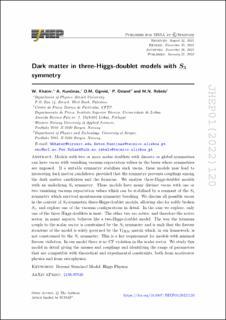| dc.contributor.author | Khater, W. | |
| dc.contributor.author | Kunčinas, A. | |
| dc.contributor.author | Øgreid, Odd Magne | |
| dc.contributor.author | Osland, Per | |
| dc.contributor.author | Rebelo, M.N. | |
| dc.date.accessioned | 2023-03-14T10:24:20Z | |
| dc.date.available | 2023-03-14T10:24:20Z | |
| dc.date.created | 2022-05-13T10:50:39Z | |
| dc.date.issued | 2022 | |
| dc.identifier.citation | Journal of High Energy Physics (JHEP). 2022, 2022 (1), . | en_US |
| dc.identifier.issn | 1126-6708 | |
| dc.identifier.uri | https://hdl.handle.net/11250/3058109 | |
| dc.description.abstract | Models with two or more scalar doublets with discrete or global symmetries can have vacua with vanishing vacuum expectation values in the bases where symmetries are imposed. If a suitable symmetry stabilises such vacua, these models may lead to interesting dark matter candidates, provided that the symmetry prevents couplings among the dark matter candidates and the fermions. We analyse three-Higgs-doublet models with an underlying S3 symmetry. These models have many distinct vacua with one or two vanishing vacuum expectation values which can be stabilised by a remnant of the S3 symmetry which survived spontaneous symmetry breaking. We discuss all possible vacua in the context of S3-symmetric three-Higgs-doublet models, allowing also for softly broken S3, and explore one of the vacuum configurations in detail. In the case we explore, only one of the three Higgs doublets is inert. The other two are active, and therefore the active sector, in many aspects, behaves like a two-Higgs-doublet model. The way the fermions couple to the scalar sector is constrained by the S3 symmetry and is such that the flavour structure of the model is solely governed by the VCKM matrix which, in our framework, is not constrained by the S3 symmetry. This is a key requirement for models with minimal flavour violation. In our model there is no CP violation in the scalar sector. We study this model in detail giving the masses and couplings and identifying the range of parameters that are compatible with theoretical and experimental constraints, both from accelerator physics and from astrophysics. | en_US |
| dc.language.iso | eng | en_US |
| dc.publisher | Springer | en_US |
| dc.rights | Navngivelse 4.0 Internasjonal | * |
| dc.rights.uri | http://creativecommons.org/licenses/by/4.0/deed.no | * |
| dc.title | Dark matter in three-Higgs-doublet models with S <inf>3</inf> symmetry | en_US |
| dc.type | Peer reviewed | en_US |
| dc.type | Journal article | en_US |
| dc.description.version | publishedVersion | en_US |
| dc.rights.holder | © The Authors | en_US |
| dc.source.pagenumber | 0 | en_US |
| dc.source.volume | 2022 | en_US |
| dc.source.journal | Journal of High Energy Physics (JHEP) | en_US |
| dc.source.issue | 1 | en_US |
| dc.identifier.doi | 10.1007/JHEP01(2022)120 | |
| dc.identifier.cristin | 2024275 | |
| dc.source.articlenumber | 120 | en_US |
| cristin.ispublished | true | |
| cristin.fulltext | original | |
| cristin.qualitycode | 2 | |

